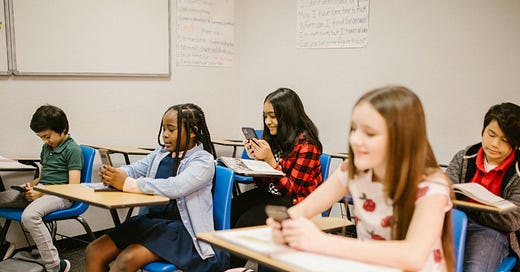Hello Bar-setters,
Let’s start with an excellent excerpt from Abigail Shrier’s Bad Therapy:
“Tic disorders, gender dysphoria, anorexia, dissociative identity disorder, trichotillomania, cutting: the parade of horribles induced by smartphones could fill a psychiatric manual of its own. If smartphones were a boy who wanted to see your daughter, a generation ago, parents would have taken one look at him and said: No way am I letting that kid in the door….
…that ought to have provided our eager mental health experts with an obvious mandate: treat social media like cigarettes. Call to restrict smartphones from middle school and high school campuses. Urge companies to place a black-box warning on social media…
…They didn’t… They’ve been preoccupied with their own style and method of intervention. Because any parent can take away a phone, but only a psychologist can diagnose a child or refer for medication….
…smartphones have become one more mental health accommodation we disburse to the young. We know it isn’t good for them. We know the long-term consequences run from dark to dire. We know the devices are addictive, sleep-depriving, and pathology-inducing. But for right now, they provide unbeatable palliative care—soothing as any blankie.”
Source: Bad Therapy: Why the Kids Aren’t Growing Up, by Abigail Shrier, pp. 23-24
The Digital Babysitter
Shrier nails something most people know but won’t say: we’ve handed children something deeply harmful because it makes our lives easier.
This is an underrated factor that prevents adults from doing what they know they should do related to smartphones. The smartphone is the great lobotomizer.
We see this all the time in schools. And no, the issue isn’t just TikTok dances or distracted students. It’s deeper. It’s that the smartphone has become the solution to one of the oldest and hardest problems in education: what to do with students who finish early.
In the past, teachers had to plan for this. Some gave extra work. Others kept card games and books. Many overloaded students with homework so idleness never had a chance to creep in.
But this issue went away entirely when it became acceptable to just let students sit on their smartphone.
I explained this phenomenon in my book quoting a retired mentor teacher:
“Standardized testing procedures have hardly changed since I was a little girl (the 60s and 70s). I remember I couldn’t wait to finish my test so I could grab my book and get lost in a story. I was not typical, however. When testing time finally ended and my focus was broken, chaos erupted around me. This characterized my experience teaching. The second the last test was turned in, the class slipped into pandemonium. Kids couldn’t sit still anymore. It was like trying to corral a zoo for however long you had them before lunch.
But that changed in the years before my retirement. Now, the students finish their tests and they just sit there, anxiously staring at those still working—willing them to finish so the class will be allowed to get their phones. Since the smartphone, it is as quiet after the last test has been turned in as during the test itself. And that is terrifying.”
Draw the Line
The problem with lobotomizers is they work.
They numb the chaos. Quiet the crowd. Buy a little peace.
But at what cost?
We’re not raising focused, adaptable, admirable young people. We’re raising kids who need a dopamine drip to function—and we’re the ones handing them the IV.
If you’re an educator, coach, or parent: draw the line. Ban the digital babysitter.
The world will keep pushing convenience. It’s our job to push back.
Thank you for reading and sharing with any kindred spirits!
Shane




